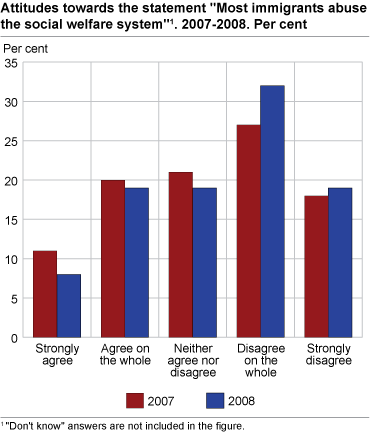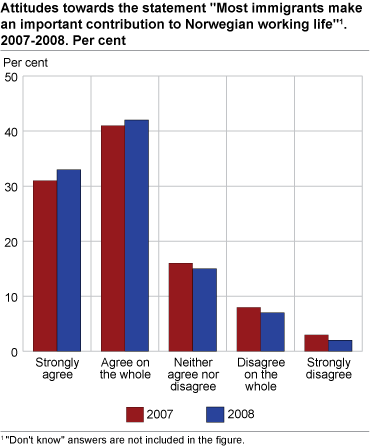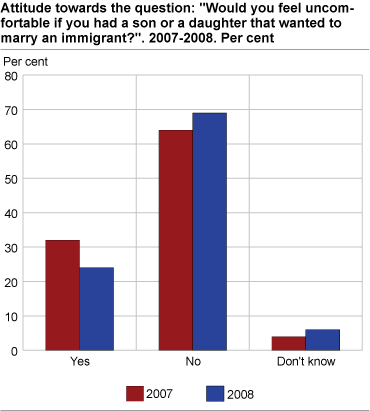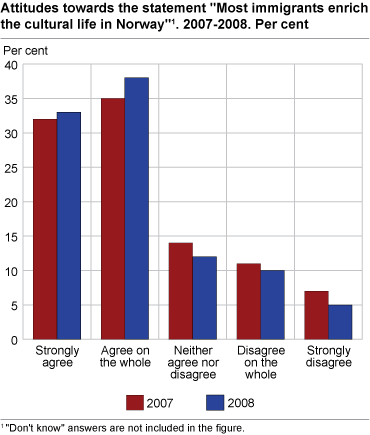Content
Published:
This is an archived release.
Attitudes to immigrants becoming more liberal
More people than before agree that immigrants make an important contribution to working life, fewer believe immigrants unjustly burden the social welfare system, and fewer take a negative stance towards a son or a daughter wishing to marry an immigrant.
The survey that deals with public attitudes towards immigrants and immigration shows that the Norwegian population held a more accepting attitude towards immigrants in 2008 than earlier years. The survey was conducted in the summer, before the global downturn of the economy had occurred.
75 per cent think that immigrants make a proper contribution to working life
According to the survey, three out of four in the adult population agree strongly or on the whole that “Most immigrants make an important contribution to Norwegian working life”. This is an increase of 3 percentage points since last year. Half of the population disagree moreover strongly or on the whole that “Most immigrants abuse the social welfare system”; an increase of 5 percentage points since last year. One out of four feel uncomfortable if a son or a daughter should wish to marry an immigrant, but the proportion is 8 percentage points lower than last year.
The survey also shows that seven out of ten persons strongly or on the whole agree that “Most immigrants enrich the cultural life in Norway”; an increase of 4 percentage points since last year. The proportion opposed to having an immigrant as a neighbour, is also descending and is now down to 6 per cent.
A probable cause for these changes, all of which point in the same direction, is the increased share of European labour immigrants in the population during the last phase of the rising business cycles in Norway. The presence of foreign workers has been broadly appreciated and may have contributed to the rise of new associations in relation to the concept of immigrants. The finding that fewer people had objections to marriage between their own children and immigrants may be related to this or stem from the fact that alliances of this nature have become less unusual.
No change in the attitude regarding reception of refugees
Surprisingly enough, no change was found in the opinion about how easy or difficult it ought to be for refugees and asylum seekers to be allowed to reside in the country - despite the strong inflow of asylum seekers during the months before the survey was conducted. The government’s launch of more restrictive rules regarding admission to asylum was not declared until a month after the fieldwork was finished and consequently had no impact on the answers.
The variation in the attitudes of the population mainly follows the same patterns as demonstrated earlier, depending of sex, age, education, place of residence, geographic region and degree of contact with immigrants. A new background variable, main economic activity, has been introduced. It shows that retired and welfare recipients are more sceptical to immigrants and immigration than those gainfully employed or enrolled in education or students. A large part of this relationship is however due to age differences.
Manifest liberalisation since 2002
Compared to the attitudes expressed in 2002 when the questions were posed for the first time, there has been a manifest turn towards greater tolerance and acceptance. As an example of this, the proportion believing that most immigrants represent a source of insecurity in society has fallen by 13 percentage points from 45 to 32 per cent. Moreover, there has been a drop from 40 to 24 per cent in the proportion reporting they would find it distasteful having a son-in-law or daughter-in-law with an immigrant background.
Tables:
- Table 1 Attitudes towards six statements on immigrants. 2002- 2008. Per cent
- Table 2 Attitudes towards the statement "All immigrants in Norway should have the same job opportunities as Norwegians". 1993-2000 and 2000-2008. Per cent
- Table 3 Attitudes towards refugees' access to residence permits in Norway. 2002-2008. Per cent
- Table 4 Answers to three questions on relations to immigrants. 2002-2008. Per cent
- Table 5 Contact with immigrants in different arenas. 2002-2008. Per cent
- Table 6 Number of arenas where contact with immigrants takes place. 2002-2008. Per cent
- Table 7 Number of immigrants one has contact with. 2003-2008. Per cent
- Table 8 How often one has contact with immigrants, normally. 2003, 2007 and 2008. Per cent
- Table 9 Personal experience with the contact with immigrants. 2003, 2007 and 2008. Per cent
Contact
-
Frøydis Strøm
E-mail: froydis.strom@ssb.no
tel.: (+47) 40 81 13 17
-
Christian Sørlien Molstad
E-mail: christian.molstad@ssb.no
tel.: (+47) 46 65 99 12




